| ABC program listing for the TI-89 |
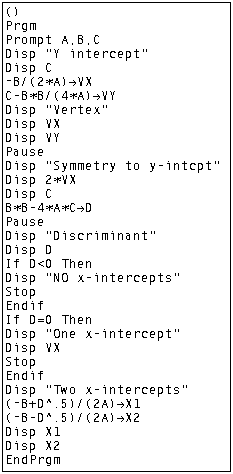 |
| Right click abc.89p for the TI-89 program |
| ABC program listing for the TI-89 |
 |
| Right click abc.89p for the TI-89 program |
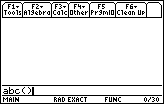
|
In Figure 1 we have entered abc() into the command line.
We will need to
press the  key to start the program. key to start the program.
|

| The program starts by asking for the values of A, B, and C, where it is
understood that we are looking at the equation
|

| Once the values have been entered, the program computes the y-coordinate
of the y-intercept, and the coordinates of the vertex of the parabola. For the
quadratic equation the vertex at (4,– 3) The program is in a "paused" state at this point. We press the ENTER key to continue. |
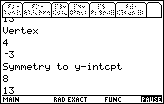
| The ABC program continues by giving us the coordinates of the point symmetric to the y-intercept. In this case, that point is (8,13). Again the program is paused and we press ENTER to continue. |
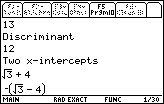
| The program concludes by computing and displaying the value of the
discriminant, 12, and then the x-coordinates of the x-intercepts.
Because the discriminant in this case is positive, there are two real roots.
Furthermore, because the value 12 is not a perfect square then
those roots will be irrational. The program produces the values
The program has finished, but we are left in the ProgramIO screen. |
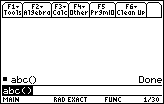
| In Figure 5a we
return to the HOME screen by pressing the
 key. Note that the
screen shows that the first run of the program completed.
Now we need to press key. Note that the
screen shows that the first run of the program completed.
Now we need to press  to run the program again. to run the program again.
|
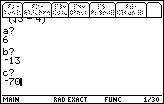
|
Now we enter the coefficients for the equation
|

| The program moves through the same steps and displays the appropriate values for the y-intercept and the vertex. |
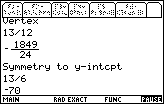
| Figure 8 continues the output by showing the coordinates of the point symmetric to the y-intercept. |
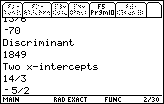
| And, the program concludes by giving the value of the discriminant and the two x-intercepts, which in this case are rational values. |

| Figure 10 starts a new equations, namely,
|
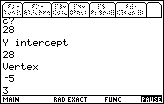
| Figure 11 shows the y-intercept and the coordinates of the vertex. |

| Figure 12 gives the coordinates of the point symmetric to the y-intercept. |
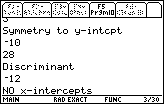
| And, Figure 13 displays the discriminant, which in this case is –12, and, therefore, there are no real solutions, and no x-intercepts. |
PRECALCULUS: College Algebra and Trigonometry
© 2000 Dennis Bila, James Egan, Roger Palay